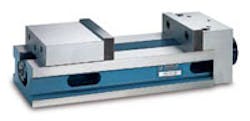True-grit part holding
When machining multiple parts in a mill vise, I fold emery cloth upon itself (grit side to grit side) and place it between the movable jaw and the parts.
Online name
justlesh, Indiana
Paper on chip control
When I’m working close to the steadyrest on a lathe, I affix a disc/washer of heavy paper or equivalent that fits firmly around the workpiece, but is several inches larger in O.D. size. I slide this washer over the workpiece, between the cutting tool and steadyrest, placing it next to the steadyrest’s bushings/bearings to keep chips from getting under the bearings.
Our shop makes a fair amount of medium-sized replacement hydraulic cylinder rods that range in size from 2 in. to 6 in. in diameter and 3 in. to 7 in. long, and we use a ballbearing steadyrest for the chromed rod surfaces. This trick has worked well in keeping the dreaded “whumpiddy whumpiddy” from tearing up the rods, as they are way too heavy for the typical delrin or bronze steadyrest bushings.
Online name
bosleyjr, Gainesville, Ga
Putty sets work right
Epoxy putty works great for leveling workpieces with irregular underside surfaces.
I roll up a few balls of that two-part epoxy putty, the kind that comes in a bi-colored coaxial rod and sets underwater. It’s available at most hardware stores. I lay out as many of these balls as needed on squares of baking paper, then place them and the squares on the machine’s bed. Place another square of baking paper on the tops of each ball. Use big pieces of baking paper if the workpiece is heavy.
With the balls in place, I lower the workpiece vertically into position and use the machine’s quill and the Z-axis readout to push the datum face as level as needed, squashing the balls of putty. Check part by tramming.
Allow the putty mounds to set, which can take a couple of hours if the shop is cold. Once set, clamp the usual way with the clamps adjacent to each wad of putty. The stuff develops serious compressive strength and stiffness.
Online name
Troup
New Zealand
Idea extends drill reach
I use Loctite to extend taps and drills for reaching tight areas. I drill a hole in the end of a piece of steel drill rod and Loctite the drill or tap in the hole. I give it about 10 minutes to set.
This has worked for drills as large as 1 in. in diameter for masonry work and for drills as small as 0.020 in. in diameter. For the smaller drills, I use 0.250-in. drill rod.
Online name
boslab
Santa Cruz, Calif.
Non-slip grip
I keep a small film canister of dry valve-grinding compound in my toolbox for removing screws with stripped heads. What I do is dip the tip of a screwdriver in the grinding compound. The extra grit/ traction keeps the screwdriver from slipping, especially on stripped Philips head screws.
If you can’t find dry valvegrinding compound, try using grinding wheel dust built up from a bench grinder. Crush it up first though.
Online name
adcarvings
British Columbia, Canada
